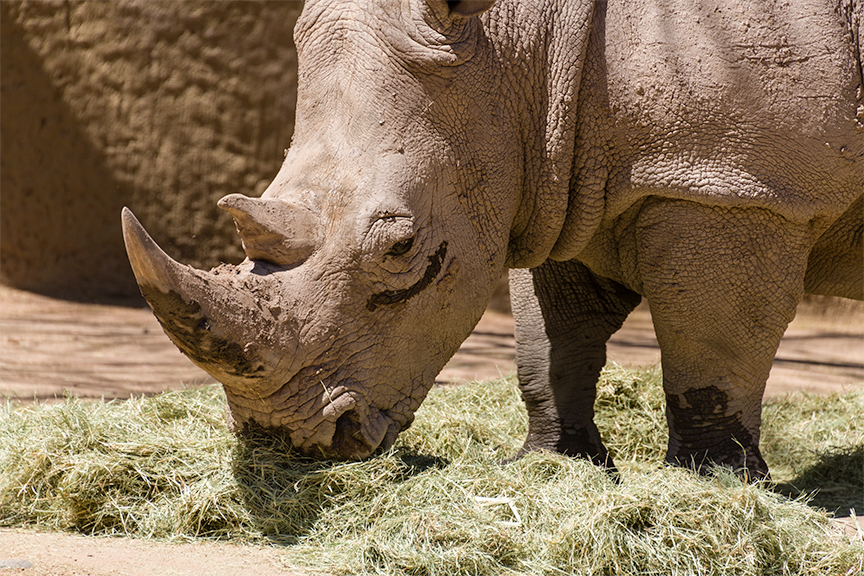Phoenix Zoo, Part 6
Leaving the dinosaurs behind, we encounter a mammal that looks dinosaurian, a Southern White Rhinoceros. While the Northern White Rhino is functionally extinct (only two older females known to exist), their Southern cousins are only Near Threatened, with some 17,460 still in the wild. Despite their current population, they are threatened with loss of habitat and continual poaching for their horns which are used in traditional Chinese medicine.

 When I took this photo, I was wondering how much do rhinos eat. A quick search found this on the Maryland Zoo's website which says, "White rhinos are eating machines. They spend about half of their waking hours eating and the rest of the time resting or perhaps wallowing in mud holes. White rhinos are very large animals that must eat up to 120 pounds of grass per day to sustain themselves. They will drink whenever and wherever they can find water but can survive up to five days without it."
When I took this photo, I was wondering how much do rhinos eat. A quick search found this on the Maryland Zoo's website which says, "White rhinos are eating machines. They spend about half of their waking hours eating and the rest of the time resting or perhaps wallowing in mud holes. White rhinos are very large animals that must eat up to 120 pounds of grass per day to sustain themselves. They will drink whenever and wherever they can find water but can survive up to five days without it."
 Next is a Mandrill — an Old World monkey native to tropical rainforests in Africa. They are the world's largest monkey.
Next is a Mandrill — an Old World monkey native to tropical rainforests in Africa. They are the world's largest monkey.
 I think they have a most interesting face with no hair but with racing stripes.
I think they have a most interesting face with no hair but with racing stripes.
 This one eventually came over close to the window so we could see him better — or was it so he could see us better?
This one eventually came over close to the window so we could see him better — or was it so he could see us better?
 In the next pavilion, a Hamadryas baboon came over to get a closer look at the "hairless apes". Those eyes definitely show the intelligence of these creatures. Perhaps that is why this species was considered sacred by the ancient Egyptians.
In the next pavilion, a Hamadryas baboon came over to get a closer look at the "hairless apes". Those eyes definitely show the intelligence of these creatures. Perhaps that is why this species was considered sacred by the ancient Egyptians.
 Beyond the primate enclosures we find a couple of Gerenuks, a long-necked antelope found in the Horn of Africa and the drier parts of East Africa. They are also known as giraffe gazelles because of their long necks.
Beyond the primate enclosures we find a couple of Gerenuks, a long-necked antelope found in the Horn of Africa and the drier parts of East Africa. They are also known as giraffe gazelles because of their long necks.
The males will develop long, attractive horns shaped like a lyre. I suspect that will also make them a popular target for trophy hunters.
 Just steps away was a young Gerenuk. Note the long, spindly legs. In the wild, they must be able to stand and run soon after birth to in order to avoid predators.
Just steps away was a young Gerenuk. Note the long, spindly legs. In the wild, they must be able to stand and run soon after birth to in order to avoid predators.
 Resting in the shade is (as everyone knows) the fastest land animal on Earth, a cheetah. We have all seen videos of a running cheetah with what looks likes springs in its flexible body and the ability to change direction on a dime. Sadly, these magnificent animals are classified as Vulnerable to extinction due to habitat loss as well as killing by farmers due to their misunderstanding that cheetahs could be a threat to livestock. Sadly, there are only 7,100 individuals left in the wild.
Resting in the shade is (as everyone knows) the fastest land animal on Earth, a cheetah. We have all seen videos of a running cheetah with what looks likes springs in its flexible body and the ability to change direction on a dime. Sadly, these magnificent animals are classified as Vulnerable to extinction due to habitat loss as well as killing by farmers due to their misunderstanding that cheetahs could be a threat to livestock. Sadly, there are only 7,100 individuals left in the wild.
 Another animal that everyone knows — a camel. As the next photo shows, this one has only one hump and thus is, more correctly, a dromedary, which makes up 94% of the world's camel population.
Another animal that everyone knows — a camel. As the next photo shows, this one has only one hump and thus is, more correctly, a dromedary, which makes up 94% of the world's camel population.
The camel was domesticated in ancient times and used for transportation (both humans and cargo) as well as food and fabric. Today, the Zoo uses them to make money to help their wildlife preservation programs.
